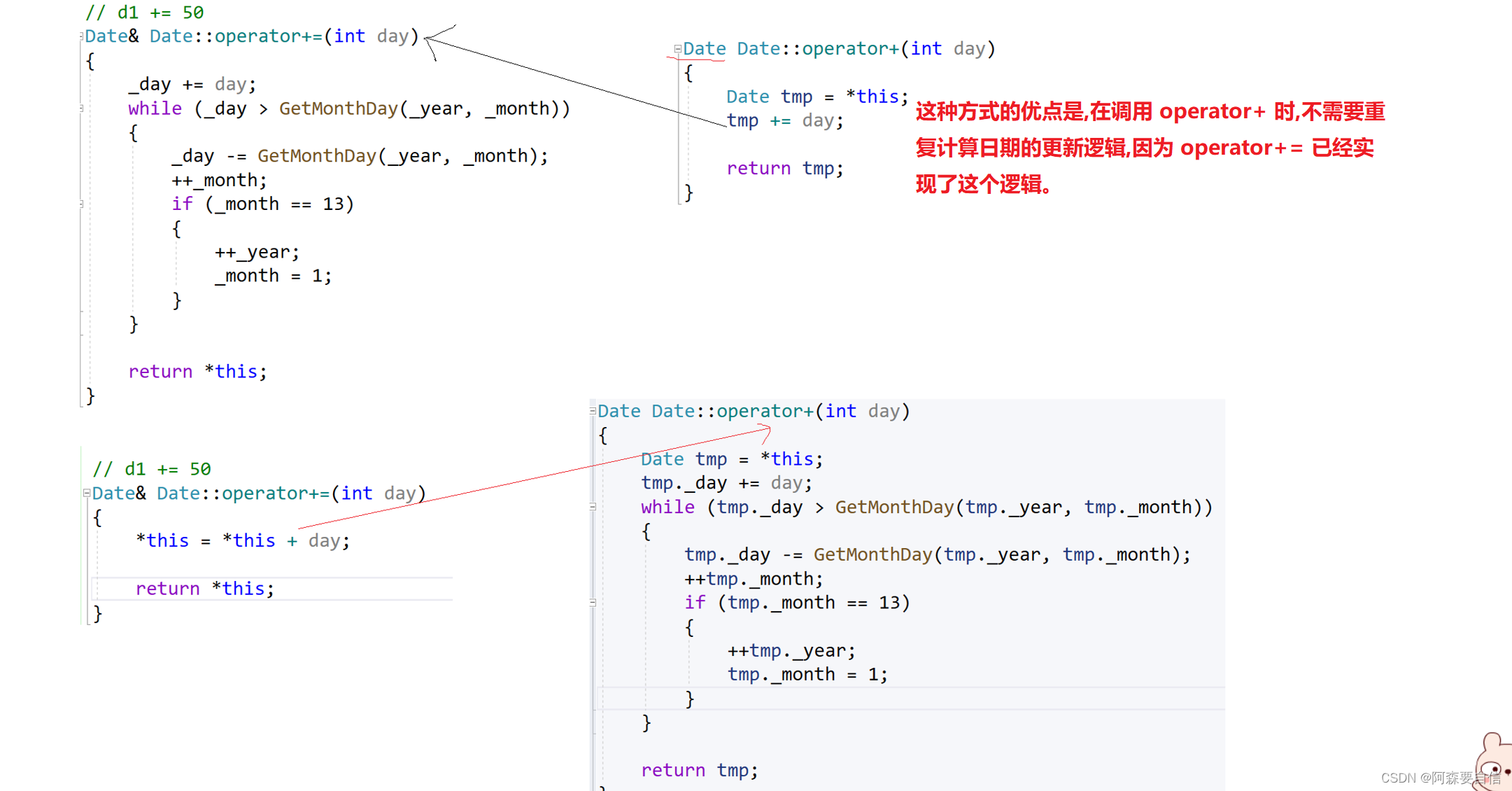
文章目录
📝前言
通过前面学完了C++的默认成员函数,实践出真知,本小节我们将一起来实现一个简单上手的日期时间计算器,阿森和你一起一步一步的操作实现!
完整代码在文章末尾哦

🌠 头文件Date.h
为了代码的维护性和可观型,我们在设置三个文件头文件Date.h,源文件Date.cpp,Test.cpp
我们先把头文件该写的写上:
#pragma once
#include<iostream>
using namespace std;
#include <stdbool.h>
#include <assert.h>
class Date
{
public:
//全缺省构造函数
Date(int year = 1, int month = 1, int day = 1);
//拷贝构造函数:由于我们知道Date这种类,可写构造也可以不写,可以让编译器自动生成
Date(const Date& d);
//析构函数;和拷贝构造函数一样,可写也可以不写
~Date()
//打印函数,检验每一步代码错误
void print();
Date& operator+(const Date& d);
private:
//内置类型:缺省值可给不给
int _year = 1;
int _month = 1;
int _day = 1;
};
此时此刻,我们接下来要源文件Date.c来实现全缺省的构造函数:
Date::Date(int year, int month, int day)
{
_year = year;
_month = month;
_day = day;
}
注意:这里我们全缺省构造函数进行声明与定义分离时,源文件定义时不需要缺省,也就是不要带值,否则如下图:将会重定义默认参数。

接下来我们实现打印函数:
void Date::print()
{
cout << _year << "-" << _month << "-" << _day << endl;
}
拷贝构造函数
Date::Date(const Date& d)
{
_year = d._year;
_month = d._month;
_day = d._day;
}
赋值运算符重载:
Date& Date::operator+(const Date& d)
{
if (this != &d)
{
_year = d._year;
_month = d._month;
_day = d._day;
}
return *this;
}
此时此刻,头文件大致完成了,我们接下来要来实现简单的大小比较操作:
如这些通用的运算符重载,你可以吧他们加到头文件Date.c类Date里的public中:
bool operator<(const Date& d);
bool operator<=(const Date& d);
bool operator>(const Date& d);
bool operator>=(const Date& d);
bool operator==(const Date& d);
bool operator!=(const Date& d);
这里有六个运算符重载,我们只需实现1组:第一组:<和==,第二组:>和==,其他4个可以直接调用:
我们这里实现第一组:<和==
<的运算符重载
bool Date::operator<(const Date& d)
{
// 如果当前年份小于传入日期的年份,则当前日期小于传入日期
if (_year < d._year)
{
return true;
}
// 如果年份相同,则比较月份
else if (_year == d._year)
{
// 如果当前月份小于传入日期的月份,则当前日期小于传入日期
if (_month < d._month)
{
return true;
}
// 如果月份相同,则比较日期
else if (_month == d._month)
{
// 如果当前日期小于传入日期的日期,则当前日期小于传入日期
if (_day < d._day)
{
return true;
}
}
}
// 如果以上条件都不满足,则当前日期不小于传入日期
return false;
}
==运算符重载
bool Date::operator==(const Date& d)
{
return _year == d._year
&& _month == d._month
&& _day == d._day;
}
两组都是按照年月日顺序进行逻辑判断
接下来就是有意思的调用操作了
- 小于等于意思是:小于或者等于
bool Date::operator<=(const Date& d)
{
return (*this < d) || (*this == d);
}
- 大于意思:不小于等于
bool Date::operator>(const Date& d)
{
return !(*this <= d);
}
- 大于等于:不小于
bool Date::operator>=(const Date& d)
{
return !(*this < d);
}
4.不等于就是等于的反面嘛
bool Date::operator!=(const Date& d)
{
return !(*this == d);
}
🌉日期计算函数
我们在一个日期上加天数,但是由于闰年和平年的2月的天数不同,如果在每次加,减天数,都要判断容易犯错,因此我们可以把它封装成一个函数,进行加天数的比较,我们可以定义一个数组,由于每次调用,可以设置成全局,用静态函数修饰。
int GetMonthDay(int year, int month)
{
assert(month < 13 && month>0);
static int dayArray[13] = { -1,31,28,31,30,31,30,31,31,30,31,30,31 };
if ((2 == month) && (year % 4 == 0 && year % 100 != 0) || (year % 400 == 0))
{
return dayArray[month] + 1;//也可以直接写29
}
else
{
return dayArray[month];
}
}
自身加天数类:
//d1+50
Date& operator+=(int day);
Date operator+(int day);
//d1-50
Date& operator-=(int day);
Date operator-(int day);
这里分为了两组:
你说得很对,这两个重载运算符的区别在于是否修改了原对象。
operator+=是修改原对象的:
//d1+=50
Date& Date::operator+=(int day)
{
// 将天数加到当前日期上
_day += day;
// 如果加上天数后,当前日期超过了当月的最大天数
while (_day > GetMonthDay(_year, _month))
{
// 将当前日期减去当月的最大天数
_day -= GetMonthDay(_year, _month);
// 月份加1
++_month;
// 如果月份超过了12月,则年份加1,月份重置为1月
if (13 == _month)
{
++_year;
_month = 1;
}
}
// 返回当前对象的引用
return *this;
}
这个函数直接修改了当前对象的成员变量,返回的是当前对象的引用。因此,如果使用 d1 += 50;,那么 d1 对象本身会发生改变。
实现了加等,实现加就易如反掌了
operator+是返回一个新对象:
这个函数首先创建了一个临时对象Date Date::operator+(int day) { Date temp = *this; temp += day; return temp; }temp,它是当前对象的副本。然后,它调用operator+=修改temp对象,最后返回temp。因此,如果使用d1 = d1 + 50;,那么d1对象本身不会发生改变,而是会返回一个新的Date对象。
上面是加等嵌套在加里面,下面是加嵌套在加等里面
Date Date::operator+(int day)
{
Date temp = *this;
temp += day;
while (temp._day > GetMonthDay( temp._year, temp._month))
{
day -= GetMonthDay(temp._year, temp._month);
++temp._month;
if (13 == temp._month)
{
++temp._year;
temp._month = 1;
}
}
return temp;
}
Date& Date::operator+=(int day)
{
*this = *this + day;
return *this;
}
两种方法都是要创建新的变量,效果一样,第一种创建变量,拷贝构造,然后复用+=,返回的要创建临时对象,这种方式的优点是,在调用 operator+ 时,不需要重复计算日期的更新逻辑,因为 operator+= 已经实现了这个逻辑。但是第二种,由于*this = *this + day;在*this+day中先调用+,然后在+中拷贝构造,然后返回临时对象,然后还要进行拷贝构造,对比第一种效率降低了,所以使用加复用加等性能更好

日期的加减也是如此:减等和减
Date& Date::operator-=(int day)
{
_day -= day;
if (0 == _day)
{
--_month;
_day = GetMonthDay(_year, _month);
}
while (_day <= 0)
{
--_month;
_day += GetMonthDay(_year, _month);
}
return *this;
}
// d1-50
Date Date::operator-(int day)
{
Date temp = *this;
temp -= day;
return temp;
}
🌠前后置++
// 前置递增运算符重载
// 该运算符重载函数返回递增后的日期对象的引用
Date& Date::operator++()
{
// 将当前日期对象加 1 天
*this += 1;
// 返回递增后的日期对象的引用
return *this;
}
这是前置递增运算符重载函数,它返回递增后的日期对象的引用,因此可以支持连续的前置递增操作,如 ++d1;,实现方式是调用 operator+= 函数将当前日期对象加 1 天,然后返回当前对象的引用。
// 后置递增运算符重载
// 该运算符重载函数返回递增前的日期对象
Date Date::operator++(int)
{
// 创建一个临时日期对象,保存当前日期对象的值
Date temp(*this);
// 将当前日期对象加 1 天
*this += 1;
// 返回递增前的临时日期对象
return temp;
}
这是后置递增运算符重载函数。它返回递增前的日期对象,因此可以支持后置递增操作,如 d1++;。
实现方式是:创建一个临时日期对象,保存当前日期对象的值,调用 operator+= 函数将当前日期对象加 1 天,返回保存的临时日期对象。
这两个函数的主要区别在于返回值的不同。前置递增运算符返回递增后的日期对象的引用,而后置递增运算符返回递增前的日期对象。这种差异使得它们在使用时有不同的表现。
前置递增运算符通常更高效,因为它不需要创建临时对象。后置递增运算符需要创建一个临时对象来保存原始值,然后再执行递增操作,因此会稍微慢一些。
🌉前后置–
// 前置递减运算符重载
// 该运算符重载函数返回递减后的日期对象的引用
Date& Date::operator--()
{
// 将当前日期对象减 1 天
*this -= 1;
// 返回递减后的日期对象的引用
return *this;
}
这是前置递减运算符重载函数。它返回递减后的日期对象的引用,因此可以支持连续的前置递减操作,如 --d1;实现方式是调用 operator-= 函数将当前日期对象减 1 天,然后返回当前对象的引用。
// 后置递减运算符重载
// 该运算符重载函数返回递减前的日期对象
Date Date::operator--(int)
{
// 创建一个临时日期对象,保存当前日期对象的值
Date temp(*this);
// 将当前日期对象减 1 天
*this -= 1;
// 返回递减前的临时日期对象
return temp;
}
这是后置递减运算符重载函数。它返回递减前的日期对象,因此可以支持后置递减操作,如 d1–;。
实现方式是:创建一个临时日期对象,保存当前日期对象的值。调用 operator-= 函数将当前日期对象减 1 天,返回保存的临时日期对象。
前置递减运算符通常更高效,因为它不需要创建临时对象。
🌠两对象日期相减
//d1-d2
// 日期差运算符重载
// 该运算符重载函数返回两个日期对象之间的天数差
int Date::operator-(const Date& d)
{
// 创建两个临时日期对象,分别保存较大和较小的日期
Date max = *this;
Date min = d;
// 标记变量,用于记录较大日期是否在前
int flag = 1;
// 如果当前日期对象小于传入的日期对象
if (*this < d)
{
// 交换两个临时日期对象的值,使 max 保存较大的日期
max = d;
min = *this;
// 将标记变量设为 -1,表示较小日期在前
flag = -1;
}
// 初始化天数差为 0
int n = 0;
// 循环递增较小日期,直到与较大日期相等
while (min != max)
{
// 递增较小日期
++min;
// 累加天数差
++n;
}
// 返回天数差,并根据标记变量的值确定正负
return n * flag;
}
首先创建两个临时日期对象 max 和 min,分别保存较大和较小的日期,然后判断当前日期对象是否小于传入的日期对象,如果是,则交换 max 和 min 的值,并将标记变量 flag 设为 -1,接下来,使用 while 循环递增 min 日期,直到与 max 日期相等,同时累加天数差 n,最后,根据标记变量 flag 的值确定返回值的正负,即返回两个日期对象之间的天数差。
🌉自定义流输入和输出
通常我们可以输入的时候是不是想这样输入:cin>>d1或者输出cout<<d2,如下面这个流运算符重载,我们知道重载这里有this指针,顺序是this ,cout,那么它的传参表示是d1<<cout,哇,这和我们平时的逻辑相反不可观,而且这只能定义在类里面,外部无法调用那咋办?
void Date::operator<<(ostream& out)
{
out << _year << "年" << _month << "月" << _day << "日" << endl;
}
我们可以定义在全局作用域里,
// 重载输出运算符 <<
// 该运算符重载函数用于将日期对象输出到输出流中
ostream& operator<<(ostream& out, const Date& d)
{
// 将日期对象的年、月、日输出到输出流中
// 每个数值后跟相应的单位
out << d._year << "年" << d._month << "月" << d._day << "日" << endl;
// 返回输出流对象,以支持连续输出
return out;
}
这是重载输出运算符 << 的函数。它接受一个输出流对象 out 和一个常量日期对象 d 作为参数,该函数返回输出流对象 out,以支持连续输出。
bool Date::CheckDate()
{
if (_month < 1 || _month > 12
|| _day < 1 || _day > GetMonthDay(_year, _month))
{
return false;
}
else
{
return true;
}
}
// 重载输入运算符 >>
// 该运算符重载函数用于从输入流中读取日期对象的值
istream& operator>>(istream& in, Date& d)
{
// 提示用户输入年/月/日
cout << "请依次输入年/月/日:->";
// 从输入流中读取年、月、日的值,并存储到日期对象d中
in >> d._year >> d._month >> d._day;
if (!d.CheckDate())//避免出现2024 4 0日
{
cout << "日期非法" << endl;
}
// 返回输入流对象,以支持连续输入
return in;
}
这是重载输入运算符 >> 的函数,它接受一个输入流对象 in 和一个可修改的日期对象 d 作为参数,该函数返回输入流对象 in,以支持连续输入。注意:CheckDate()为了防止输入 2024年4月0日
最后问题是在全局两个在全局变量中怎么能使用Date的内置类型呢?
没错!我是你的朋友就好啦!!!友元friend
我的朋友就可以用了嘛,这里可以定义在public里面也可以不在
#pragma once
#include<iostream>
using namespace std;
#include <stdbool.h>
#include <assert.h>
class Date
{
// 友元函数声明
friend ostream& operator<<(ostream& out, const Date& d);
friend istream& operator>>(istream& in, Date& d);
public:
//全缺省构造函数
Date(int year = 1, int month = 1, int day = 1);
//拷贝构造函数:由于我们知道Date这种类,可写构造也可以不写,可以让编译器自动生成
Date(const Date& d);
//析构函数;和拷贝构造函数一样,可写也可以不写
~Date()
//打印函数,检验每一步代码错误
void print();
Date& operator+(const Date& d);
private:
//内置类型:缺省值可给不给
int _year = 1;
int _month = 1;
int _day = 1;
};
🌉 代码
🌉 头文件Date.h
#pragma once
#include<iostream>
using namespace std;
#include <stdbool.h>
#include <assert.h>
class Date
{
//cout << d1
friend ostream& operator<<(ostream& out, const Date& d);
friend istream& operator>>(istream& in, Date& d);
public:
Date(int year = 1, int month = 1, int day = 1);
void print();
Date& operator+(const Date& d);
//定义到类里,默认是内敛函数
int GetMonthDay(int year, int month)
{
assert(month < 13 && month>0);
static int dayArray[13] = { -1,31,28,31,30,31,30,31,31,30,31,30,31 };
if ((2 == month) && (year % 4 == 0 && year % 100 != 0) || (year % 400 == 0))
{
return dayArray[month] + 1;
}
else
{
return dayArray[month];
}
}
bool CheckDate();
bool operator<(const Date& d);
bool operator<=(const Date& d);
bool operator>(const Date& d);
bool operator>=(const Date& d);
bool operator==(const Date& d);
bool operator!=(const Date& d);
//d1+50
Date& operator+=(int day);
Date operator+(int day);
//d1-50
Date& operator-=(int day);
Date operator-(int day);
// ++d1
Date& operator++();
//d1++
Date operator++(int);
// --d1
Date& operator--();
// d1--
Date operator--(int);
//d1-d2
int operator-(const Date& d);
private:
int _year = 1;
int _month = 1;
int _day = 1;
};
//cout << d1
ostream& operator<<(ostream& out, const Date& d);
istream& operator>>(istream& in, Date& d);
🌠Date.cpp
#pragma once
#include "Date.h"
// 构造函数,初始化日期对象的年月日
Date::Date(int year, int month, int day)
{
_year = year;
_month = month;
_day = day;
}
// 拷贝构造函数,创建一个新的日期对象并初始化为与给定日期对象相同的值
Date::Date(const Date& d)
{
_year = d._year;
_month = d._month;
_day = d._day;
}
// 打印日期对象的年月日
void Date::print()
{
cout << _year << "-" << _month << "-" << _day << endl;
}
// 重载小于运算符,比较两个日期对象的大小
bool Date::operator<(const Date& d)
{
// 先比较年份,如果年份小于则返回true
if (_year < d._year)
return true;
// 如果年份相同,再比较月份,如果月份小于则返回true
else if (_year == d._year && _month < d._month)
return true;
// 如果年份和月份都相同,再比较日期,如果日期小于则返回true
else if (_year == d._year && _month == d._month && _day < d._day)
return true;
// 其他情况返回false
return false;
}
// 重载小于等于运算符,比较两个日期对象是否相等或者前者小于后者
bool Date::operator<=(const Date& d)
{
return (*this < d) || (*this == d);
}
// 重载大于运算符,比较两个日期对象的大小
bool Date::operator>(const Date& d)
{
return !(*this <= d);
}
// 重载大于等于运算符,比较两个日期对象是否相等或者前者大于后者
bool Date::operator>=(const Date& d)
{
return !(*this < d);
}
// 重载等于运算符,比较两个日期对象的年月日是否相同
bool Date::operator==(const Date& d)
{
return _year == d._year && _month == d._month && _day == d._day;
}
// 重载不等于运算符,比较两个日期对象是否不相同
bool Date::operator!=(const Date& d)
{
return !(*this == d);
}
// 重载加法运算符,将两个日期对象的年月日相加
Date& Date::operator+(const Date& d)
{
if (this != &d)
{
_year = d._year;
_month = d._month;
_day = d._day;
}
return *this;
}
// 重载加等于运算符,将当前日期对象加上指定的天数
Date& Date::operator+=(int day)
{
_day += day;
while (_day > GetMonthDay(_year, _month))
{
_day -= GetMonthDay(_year, _month);
++_month;
if (13 == _month)
{
++_year;
_month = 1;
}
}
return *this;
}
// 重载加法运算符,创建一个新的日期对象并将当前日期对象加上指定的天数
Date Date::operator+(int day)
{
Date temp = *this;
temp += day;
return temp;
}
// 重载减等于运算符,将当前日期对象减去指定的天数
Date& Date::operator-=(int day)
{
_day -= day;
if (0 == _day)
{
--_month;
_day = GetMonthDay(_year, _month);
}
while (_day <= 0)
{
--_month;
_day += GetMonthDay(_year, _month);
}
return *this;
}
// 重载减法运算符,创建一个新的日期对象并将当前日期对象减去指定的天数
Date Date::operator-(int day)
{
Date temp = *this;
temp -= day;
return temp;
}
// 重载前置递增运算符,将当前日期对象加1天
Date& Date::operator++()
{
*this += 1;
return *this;
}
// 重载后置递增运算符,将当前日期对象加1天并返回原始值
Date Date::operator++(int)
{
Date temp(*this);
*this += 1;
return temp;
}
// 重载前置递减运算符,将当前日期对象减1天
Date& Date::operator--()
{
*this -= 1;
return *this;
}
// 重载后置递减运算符,将当前日期对象减1天并返回原始值
Date Date::operator--(int)
{
Date temp(*this);
*this -= 1;
return temp;
}
// 重载减法运算符,计算两个日期对象之间的天数差
int Date::operator-(const Date& d)
{
Date max = *this;
Date min = d;
int flag = 1;
if (*this < d)
{
max = d;
min = *this;
flag = -1;
}
int n = 0;
while (min != max)
{
++min;
++n;
}
return n * flag;
}
// 重载输出运算符,将日期对象的年月日输出到流中
ostream& operator<<(ostream& out, const Date& d)
{
out << d._year << "年" << d._month << "月" << d._day << "日" << endl;
return out;
}
// 检查日期是否合法
bool Date::CheckDate()
{
if (_month < 1 || _month > 12 || _day < 1 || _day > GetMonthDay(_year, _month))
return false;
else
return true;
}
// 重载输入运算符,从输入流中读取年月日并创建日期对象
istream& operator>>(istream& in, Date& d)
{
cout << "请依次输入年/月/日:->";
in >> d._year >> d._month >> d._day;
if (!d.CheckDate())
cout << "日期非法" << endl;
return in;
}
🌉 Test.cpp
# define _CRT_SECURE_NO_WARNINGS 1
#include<iostream>
using namespace std;
#include "Date.h"
void TestDate1()
{
Date d1(2024, 4, 14);
Date d2 = d1 + 50;
d1.print();
d2.print();
Date d3(2024, 4, 14);
Date d4 = d3 - 50;
d3.print();
d4.print();
}
void TestDate2()
{
Date d1(2024, 4, 14);
Date d2 = ++d1;
d2.print();
Date d3(2024, 4, 14);
Date d4 = d3++;
d4.print();
}
void TestDate3()
{
Date d1(2024, 4, 14);
Date d2 = --d1;
d2.print();
Date d3(2024, 4, 14);
Date d4 = d3--;
d4.print();
}
void TestDate4()
{
Date d1(2024, 4, 14);
Date d2(2020, 9, 1);
int n = d1 - d2;
cout << n << endl;
}
void TestDate5()
{
Date d1(2024, 4, 24);
Date d2 = d1 + 5000;
cout << d1;
cout << d2;
cin >> d1 >> d2;
cout << d1 << d2;
}
int main()
{
TestDate5();
return 0;
}
🚩总结
